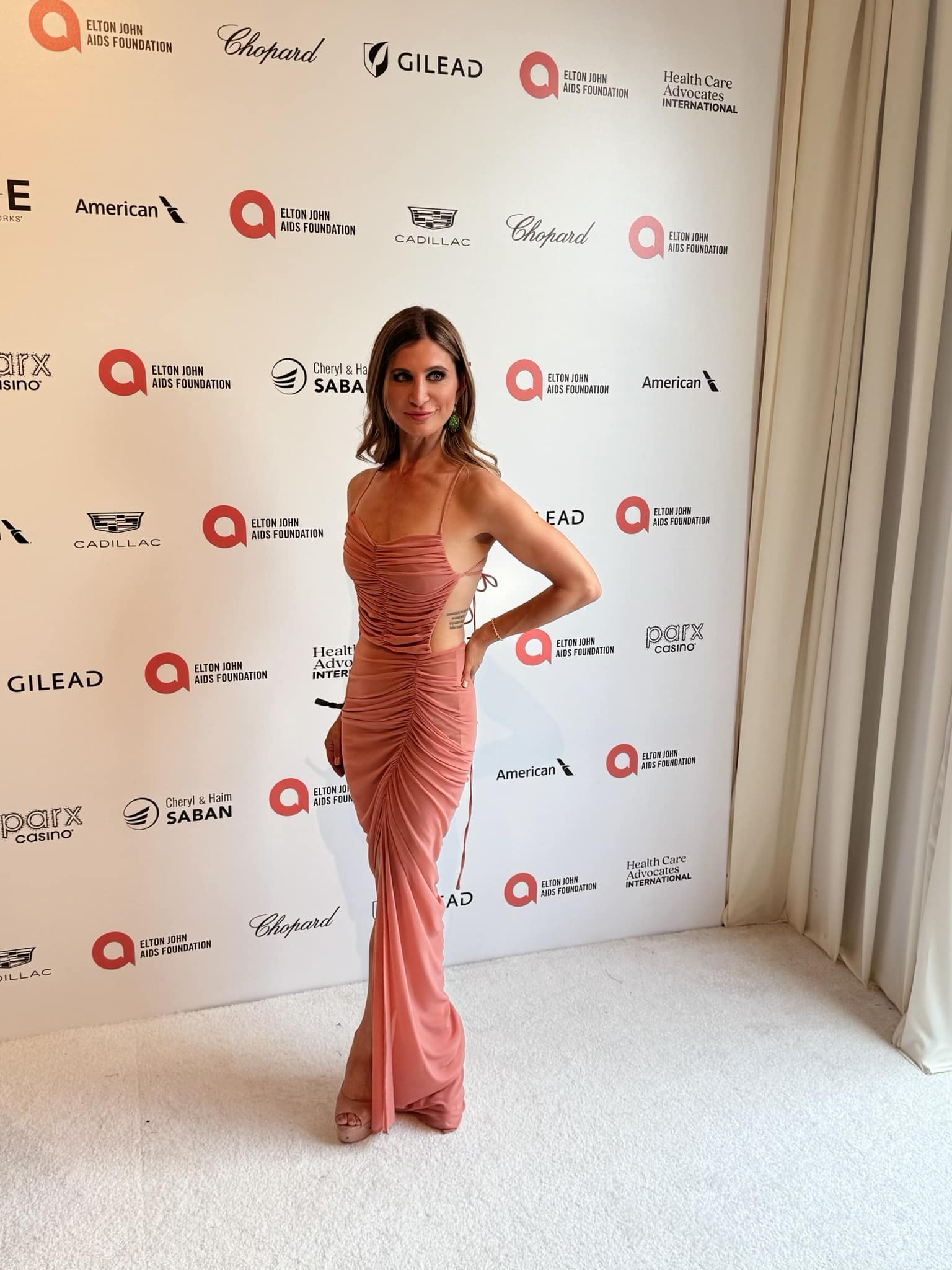How Hall Of Fame Golfer Greg Norman Turned His Name Into One Of The Most Recognizable Brands In The Business
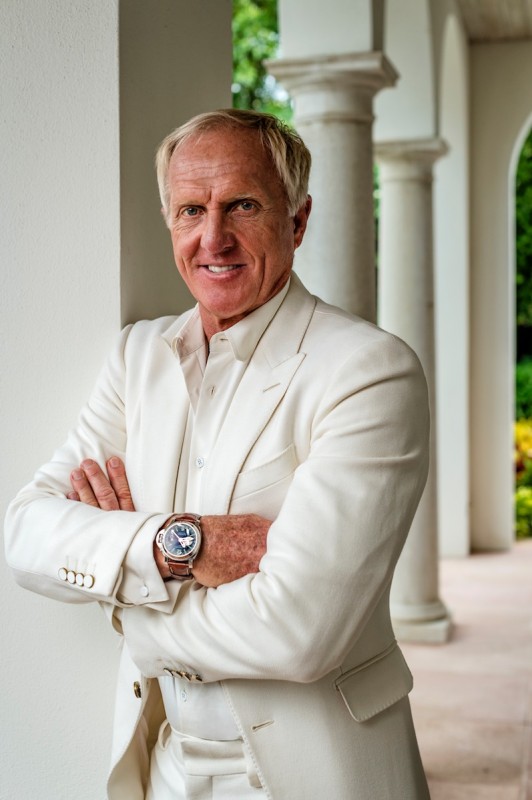
Photo Credit: Nick Garcia
Photography: Nick Garcia
Styling: Veronica Garrote
Grooming: Cesar Ferrette
Shot on location at 332 S. Beach Road, Hobe Sound, Fla.
Presiding over his multimillion-dollar empire on Florida’s Jupiter Island, Greg Norman—barefoot, tanned and relaxed in linen, looks more like a laid-back king then he does, say, a shark—the nickname he’s held since his aggressive, career-making play at the 1981 Masters (and also because he was known for shooting at the Great Whites that messed up his fishing excursions at home in Queensland, Australia, but that’s another story for another time).
And though he might look like Cool Hand Luke, there’s no way to have amassed such fame and fortune without “heaps” of ambition, enterprising and smarts (“sharky-ness,” one might even say) to transform himself from a top-ranked golfer into the household branded name that he is—and has—today.
Truthfully though, the sobriquet has been apt his entire life. He attacked learning his chosen sport with a ferocious dedication and intensity after caddying for his mother at age 15 and self-instructing by reading the Jack Nicklaus book Golf My Way until he played to a scratch handicap. Soon after, he went pro, winning his first professional event, the West Lakes Classic in 1976, at 21.
From there, the wins came fast and furiously. Norman was the top-ranked player in the world for six years—the second-longest reign in history—which earned him a place in the World Golf Hall of Fame (with a higher percentage of votes than any other inductee in history). He is an undisputed sports legend; one of the greatest golfers of all time, winning more than 90 tournaments worldwide, including two Open Championships. He is also a five-time recipient of the Byron Nelson Award, a three-time Vardon Trophy winner, three-time Arnold Palmer Award winner, the 1995 PGA Tour Player of the Year and the first player in Tour history to surpass $10 million in career earnings.
Yet, never in his wildest dreams did Norman, now 64, imagine his life turning out quite this way. “When I first started playing golf, I never had ambitions to be the No. 1 player in the world—I just had ambitions to be the best I could be,” he says. “If your only ambition is to be the best in the world, once you’ve gotten there, there’s no further mountain to climb. If you want to be the best you can be, you keep getting better and better at other things. It’s taken me 40 years; this didn’t happen overnight. Nothing happens overnight.”
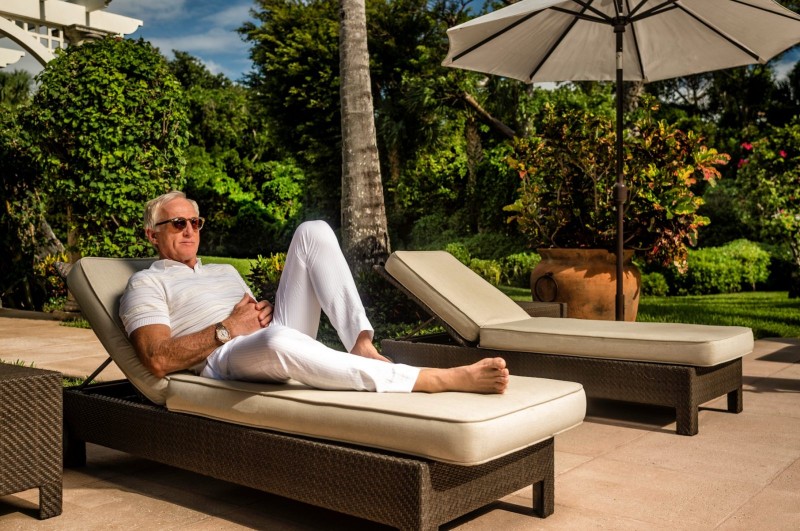
WATCH: OMEGA
Photo Credit: Nick Garcia
But when things evolve organically, at a manageable pace, it’s hard not to see every success, big or small, as a major win. Kick-starting his brand was, of course, the former. He was representing Reebok during his days as a No. 1 seeded player when brand owner Paul Fireman offered him the opportunity to start the Greg Norman Collection, of
which his logo—“easily” his self-proclaimed greatest achievement—was born. “We started the collection, designed the shark logo, he gave me back my logo and licensed it off me, and that’s how I learned branding and marketing 101. I was dumped into the deep end and had to learn how to swim,” he recalls.
And apparently, he’s a quick study. The Greg Norman Company now has 12 different, completely diverse divisions across a multitude of platforms, each built to last. “I don’t do anything today to be rewarded tomorrow. I do things today to be rewarded over a long period of time,” he maintains.
There’s his athleisure line, the Greg Norman Collection, and Greg Norman Eyewear. He owns Shark Wake Park, a leisure center dedicated to wakeboarding, and the Shark Experience, connected golf carts offering premium digital experiences to golfers seeking to improve their game. There is Greg Norman Developments, an international real estate firm, and Norman Design Group, which specializes in interiors.
He also owns Greg Norman Investments, the Greg Norman Australian Grille in Myrtle Beach, South Carolina, founded the Greg Norman Estates wine label, which is a staple on the “Top 100 Wines in the World” list, and even has his own line of beef jerky. Along the way, he found time to publish his autobiography, The Way of the Shark, and create (and sell) a production company.
And those are just the companies he owns. Norman also serves as a tourism ambassador for Vietnam and has just signed on as an ambassador for Delta Private Jets, a perfectly symbiotic relationship given Norman’s love of travel.
It’s mind-boggling, really (and OK, we admit it, a little exhausting); even he is aware of it. “Golf was a great platform for me,” he admits.
And, as if he doesn’t have enough on his plate, he announced a surprising business move earlier this year—a line of CBD personal care products for active men and women in collaboration with Authentic Brands Group and GGB Beauty.
Although the move didn’t seem like a traditional one for Norman, he’s happy to defend it. “You have to study it and understand it,” he notes. “As this industry grows in an exponential growth curve globally, and as each state in the U.S. gets more and more opened up to CBD, the opportunity is huge.”
He adds, “The health and wellness space to me is extremely important and really intrigues me. Really, why not improve the quality of your life?”
We couldn’t agree more.

Photo Credit: Nick Garcia
Whether he’s hiking in Kyrgyzstan, climbing volcanos in the Atacama Desert, designing a golf course in South Africa, opening a restaurant in Australia or producing a new wine in California, Greg Norman is consistently on the move with a serious case of wanderlust, pausing most frequently at his newly renovated home on Jupiter Island (an eight-acre estate that he initially procured during his golfing days for its proximity to the ocean and accessibility), though his latest project—the 834-acre Norman Estates at Rancho San Lucas through his Greg Norman Developments—did force him to pause, even if just for a moment.
“When I first saw [the untouched site], I was completely taken aback, to tell you the truth,” he admits. “Looking down at the full expanse of the property and seeing the Pacific Ocean over the horizon… It was just ‘Wow.’”
Early buzz around the picture-perfect, private community, which is located on a beautiful 1.2 mile stretch of beach just 15 minutes from downtown Cabo San Lucas, indicates that the “wow” sentiment is widespread. Nearly 40 percent of its 32 single-level estate homes and 36 luxury residences, priced between $3.7 and $7 million, have already sold thanks to an advance whisper campaign. A model villa reveal and meet and greet with Norman himself in March may have helped to increase that number in recent months.
Finding the right real estate project in Mexico was a no-brainer for Norman, who’s been a regular in the country for over 30 years, diving through cenotes on the Yucatán Peninsula and fishing in Cabo for fun before business brought him back. He has six self-designed golf courses cross-country (Rancho San Lucas will be his seventh) in locales like Cancún and Riviera Maya. “I’ve had a constant feed of projects [in Mexico] for a long, long period of time [including] a lot of working relationships with the government, ministers of tourism and presidents,” he says. “I even hosted the first PGA Tour event in Mexico, at [a golf course he built], Mayakoba. I’ve had the unique chance of getting to know Mexico extremely well. My tentacles go deep in that country.”
Like everything bearing his name, the former golf pro known globally as “The (Great White) Shark” has made sure that his first branded real estate development in Mexico—a collaboration with Solmar Group
President Francisco “Paco” Bulnes—stays true to his distinctive, approachable luxury aesthetic. As with his seven other Norman Estates ventures in Dubai, Ho Chi Minh City and Da Nang, Vietnam, Australia, Palm Springs, California, as well as in Panama City Beach and Naples, Florida, he makes sure that the décor is authentic to its surroundings. At Rancho San Lucas, he brought in someone very close to home to help with the coastal, hacienda-style furbishing: his wife of nine years, Kiki, an interior designer whose credits include the Fairmont Cairo and Park Hyatt Zurich.

Photo Credit: Greg Norman Real Estate
Working together for the first time on a real estate project, the couple created a space of rich textures and masculine furnishings set amid a neutral backdrop of earth tones. It’s a comfortably luxe locale where one could slip off his or her Gucci loafers and enjoy walking shoeless through the sand (as they themselves do). “It has a barefoot, elegant feel, a very Mexican feel,” he says, before noting, “It’s very relaxed—and that’s my lifestyle, my DNA. That’s how I live my life [at home] in Colorado, in Florida or on my boat… I do like the finer things in life around me, but I do not like decadence and opulence. I’m very understated in a lot of ways.”
That pretty much sums up Norman’s brand: understated yet refined. What you see is what you get, and that sentiment is echoed through each of his various projects, including Rancho San Lucas. The residents there will enjoy Norman’s brand of casual luxury with all of the things he himself indulges in at home. Amenities here will include a private, members-only beach club, dining options, a fitness center, shopping, sports complex, tennis courts, game room, infinity pool, luxury resort, 24-hour security and a 15-acre lake for water sports like kayaking and paddle boarding. The biggest draw for residents, of course, will be one of Norman’s signature golf courses—and this particular green is going to be a doozy.
The Greg Norman Signature Golf Club is projected to be one of the most majestic courses in North America, if not the world: a par 72, 7,245-yard, 18-hole championship green on the tip of the Baja Peninsula with seven holes on the beach. Landscaping includes liberally peppered giant Mexican cardon cactus as well as an island green with routing that winds its way around golden sand dunes and through arroyos down to the Pacific (keeping the native landscape intact as part of Norman’s “least disturbance” philosophy).
Will it play as well as it looks? No doubt, though Norman himself refuses to even sneak a putt until the course is finished this fall. “It’s still being grassed in,” he tells us, adding, “I never hit a ball on any of my courses under construction—I always wait until opening day.”
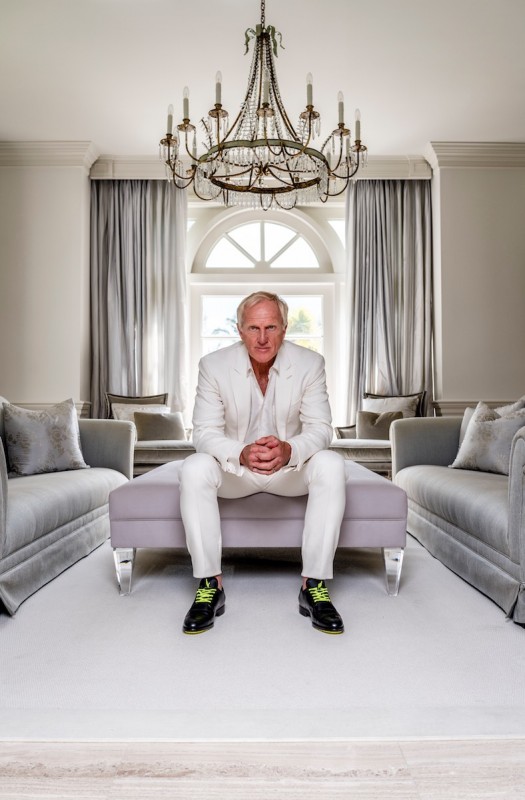
Photo Credit: Nick Garcia
Thus far, that’s 106 times he’s had to wait to play, given that the golf course design arm of his Greg Norman Company has that many courses in operation around the world, with almost 20 more under construction and an additional 40 under contract.
Not that he minds waiting—he isn’t really golfing much these days, anyway. In 2018, he played only six or seven times total, and this year isn’t projected to be markedly different. “I don’t have the desire [to play],” he admits. “I don’t like to hit golf balls anymore.”
Similarly, nor would he describe himself as shark-like these days. “It’s pretty hard to get away from [my nickname],” he says with a laugh, before noting, “I would describe myself as more of a sport diplomatist at the moment. I’m not afraid of supporting situations or issues that I believe we can improve. I’m not afraid to get up on a pedestal and tout what we can do through golf hospitality to open up free-market capitalism, economic growth, prosperity and sustainability in different countries. I work with the Mexican government, Middle Eastern government, Vietnamese government and the Australian government. I’m about the only one in my industry who focuses on golf and sport diplomacy in every part of the world.”
Norman believes he is uniquely qualified to speak about sport as a unifier. After all, he is a bona fide, die-hard Aussie who has made his living and built his brand on the American Dream. “I do think I’m American in my business philosophy,” he admits. “I think I’m a conservative centrist in a lot of ways because of how much I travel around the world. I still believe my Australian blood is the strongest part of me; I still want to go home to Australia and live there for the rest of my life. I could go there tomorrow or yesterday and be very, very happy, but America is really where it all happened for me. America gave me my opportunities. There is nowhere else in the world I could have started and done what I’ve done.
“I’ve been successful because of the American spirit and the American opportunity, and I think I’m in a pretty good place in life, quite honestly,” he continues, adding, “Could I have done it in Australia? Maybe, but on a smaller scale. Could I have done it in the U.K.? Maybe, but on an even smaller scale. Here in the United States, with the reach it’s got and the reputation it has for allowing people to chase their dreams, it was doable… And I’m not afraid to go after things.”
Said, we feel (even if he doesn’t these days), like a real shark.
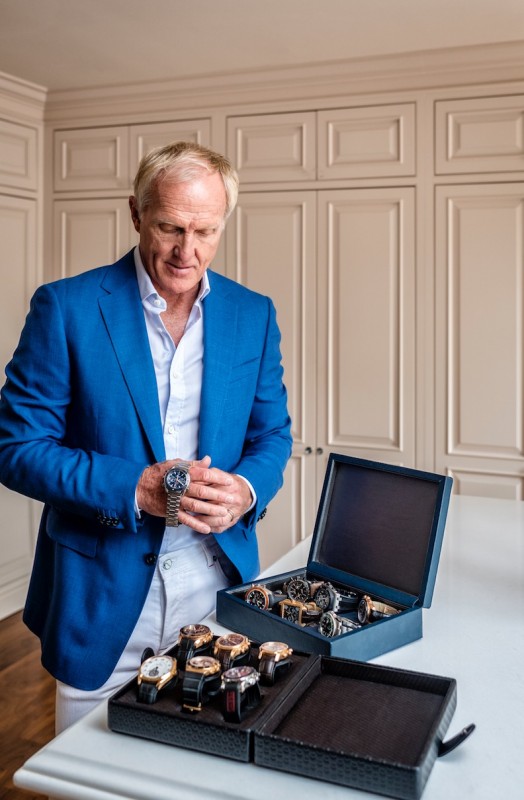
(AVAILABLE AT SAKS BAL HARBOUR) WATCH: OMEGA
Photo Credit: Nick Garcia

